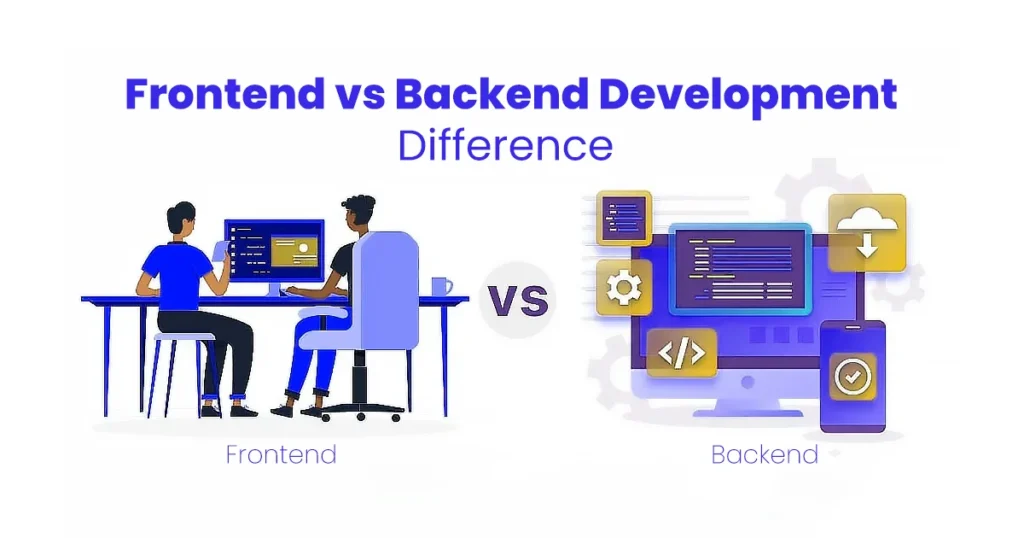To someone who is not familiar with programming, it seems to be all about writing logic to make machines functional. But understanding frontend vs backend development reveals how Web development is divided by intentions, tools and state of mind.
Frontend Development generates the tales of the digital space, entailing animations and interactions to weave narratives through designs. Backend Developers are the strategists who create an underlying framework to enable transformational experiences based on user actions.
For those curious enough about why the internet behaves like it does and perhaps, more importantly from where they might fit into the creation of that internet, this blog will demystify Frontend vs Backend Development; these will go on to uncover the differences, technologies involved, and even tackle the perennial question: Frontend vs Backend: Which One Should You Learn First?
What is Frontend Development?
The concept of Frontend Development actually refers strictly in terms of client-side implementation on a website or application. Within it lies any part of a site or application that users would be able to see, touch, and feel on their screens-the user interface.
This is basically developing the user interface and user experience of a site or an application. From navigation menus to buttons, typography, and animations, frontend developers create everything you can view on the screen.
Common Frontend Technologies:
- HTML (Hypertext Markup Language): It plays an important role in the structure and content of web pages.
- CSS (Cascading Style Sheets): Used to style HTML elements such as layout, text and colour.
- JavaScript: Providing interactivity through dynamic content and handling events.
Popular Frontend Frameworks & Libraries:
- React.js: A highly flexible JavaScript Library created by Facebook.
- Angular: A fully-fledged Google framework for building large-scale applications.
- Vue.js: Simple and flexible, especially used in small apps.
- Bootstrap: A CSS framework for responsive design.
Frontend Development Tasks Include:
- Drafting and designing pages.
- Making websites mobile-friendly.
- Creating animations and transitions.
- Improving page speed for better performance.
- Improving accessibility for every user.
What is Backend Development?
Backend development constitutes the server-side logic of websites and applications. It guarantees that accurate and safe data reaches the front end and that actions that cannot be discerned by the end user get carried out.
In layman’s terms, backend development relates to data storage, user authentication, business logic, and server configuration—essentially, the behind-the-scenes workings of an application.
Common backend technologies:
- Programming languages:
- Python (Django, Flask)
- Java (Spring Boot)
- PHP (Laravel)
- Ruby (Ruby on Rails)
- Node.js (JavaScript runtime environment)
Databases:
- MySQL
- MongoDB
- PostgreSQL
- Redis
Backend frameworks & tools:
- Express.js (for Node.js)
- Django (for Python)
- Spring (for Java)
- GraphQL (for APIs)
Backend development tasks include:
- Creating interfaces and doing server-side stuff.
- Database and data security management.
- User authentication and authorization processing.
- Integrating third-party services and cloud infrastructure.
- Scalability and server performance assurance.
Frontend vs Backend Development Difference

To fully understand the Frontend and Backend differences, it is essential to examine them from a variety of angles:
| Category | Frontend Development | Backend Development |
| Primary Focus | User Interface & User Experience | Data Management & Server Logic |
| Core Technologies | HTML, CSS, JavaScript, React, Angular, Vue | Python, PHP, Java, Node.js, Databases |
| Responsibility | Designing and building layouts, navigation, and responsiveness | Database management, APIs, server-side operations |
| Visibility | Fully visible to users | Invisible to users (operates behind the scenes) |
| Tools & Software | Design Tools, Browser DevTools, Code Editors | API Testing Tools, Databases, Cloud Platforms, Code Editors |
| Performance Considerations | Load time, responsiveness, SEO optimization | Server speed, data security, and scalability |
Frontend vs Backend Developer Responsibilities
Responsibilities of a Frontend Developer:
- Turning UI/UX into working apps.
- Optimizing web pages for speed and scalability.
- Ensuring mobile responsiveness for all devices.
- Maintaining browser compatibility on multiple platforms.
Responsibilities of a Backend Developer:
- Builds and maintains databases and servers.
- Writing APIs for frontend and mobile application integration.
- Safeguarding data security and compliance with regulations.
- Imposing authentication, authorization, and enveloping with developers’ needs.
Pros and Cons of Frontend and Backend Development
Pros of Front-end Development:
- The ability to see the work done by writing code immediately.
- In every aspect, creative freedom will be enjoyed in designing user journeys.
- Since the focus is on user experience, market demand is fairly high for front-end developers.
- Faster initial learning compared to the back end.
Disadvantages of Frontend Development:
- The speed with which tools and frameworks change can be too much to handle at times.
- Differences in browsers can make development troublesome.
- There is a risk of security threats like XSS.
Pros of Backend Development:
- Industries that highly demand work will rely on databases and APIs.
- Usually gets to work on a grand scale or enterprise-level systems.
- Relatively stable technologies that do not face frequent major changes.
- The scope of specialization includes advanced fields such as AI and cloud computing.
Cons of Backend Development:
- The higher learning curve for a beginner.
- Far less visual or immediate satisfaction in terms of work.
- Increased complexity due to data structures, algorithms, and server logic.
Frontend vs Backend Development: Which One Should You Learn First?
One of the most important questions for beginners aspiring to get into web development is this: Frontend vs. Backend: Which Should You Learn First?
Consider Frontend First If:
- You are attracted to design, visual creativity, and user interaction.
- You want projects that give rapid feedback and visible results.
- You want to get into the job market in a year or so with basic skills in HTML, CSS, and JavaScript.
- You are interested in the roles of UI/UX Developer or Frontend Engineer.
Consider Backend First If:
- You enjoy solving complex problems with logic and algorithms.
- You want to build systems for processing, storing, and securing data.
- You are intrigued by cloud computing, security, or DevOps.
- You are focusing on backend roles such as API Developer, Database Engineer, and Backend Software Engineer.
The Balanced Learning Approach:
Most aspiring web developers usually begin with Frontend Development since it requires just a little time for learning and yields quicker results. So, upon understanding a little bit of programming concepts and project flows, it becomes easier and much more enjoyable when shifting to Backend Development.
Sooner or later, everybody will want to become Full-Stack professionals in both frontend and backend technologies.
The Rise of Full-Stack Development
Full-stack development has become the need-of-the-hour skill set in the tech industry. Full-stack developers may engage in user interfaces and server logic as well as database management.
Benefits of Being a Full-Stack Developer:
- More flexibility concerning how to deal with projects.
- A higher ceiling potential.
- A more comprehensive view of system architecture.
- Greater problem-solving capabilities across diverse domains.
Both Frontend vs Backend Development ensure in equal measure that the world’s digital ecosystem is evolving. Which one you choose depends on personal preference and professional aims, as well as long-term goals.
While understanding the differences between Frontend vs Backend development, their technologies, the roles of developers in each, and the advantages and disadvantages of both, one is indeed ready to choose wisely. No matter whether you’re going to be a frontend, backend, or full-stack developer, one thing is prescribed to make it big in this business enduring pursuit of knowledge and practice in real-world applications.
Start with the subject that you love most, and then broaden the people to create your opportunities in this technology-hungry world.
FAQ’s
Back End: Python, Java, PHP, Node.js, MySQL, MongoDB





